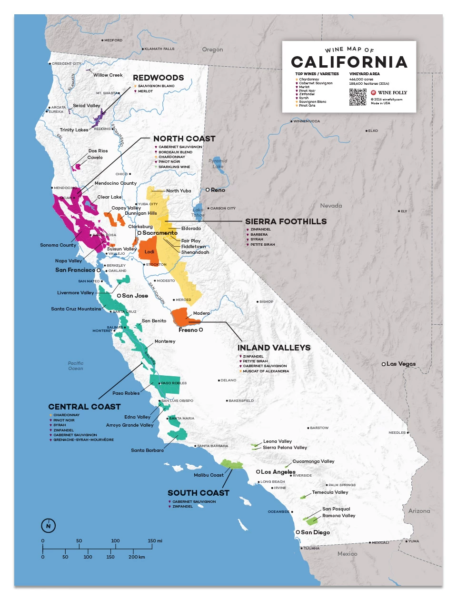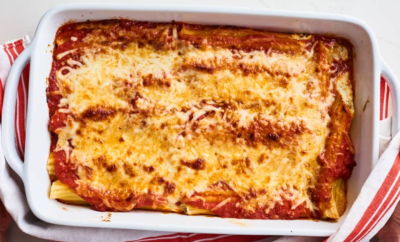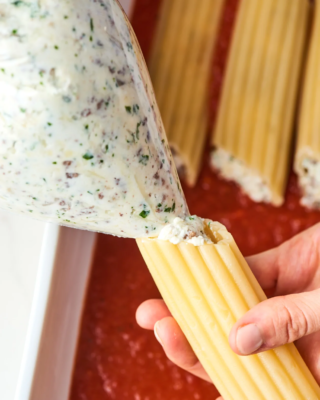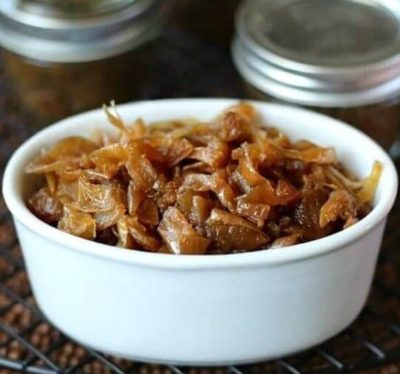Central Coast
The Central Coast is a large encompassing American Viticultural Area (AVA) that extends from the south of San Francisco all the way to Santa Barbara, California. The region contains 40 AVAs including Paso Robles, Santa Cruz Mountains, Monterey, and Santa Barbara and each of these sub-regions specializes in different types and expressions of wine. While the Central Coast may not have the same namesake as Napa Valley, it does happen to produce some of California’s most intriguing, up-and-coming wines. The majority of the vineyards can be found in the valleys that open up to the Pacific. The benefit of being along the coast is that the cold, moist air gets pulled in and creates a layer of morning cloud cover which reduces temperatures and sun exposure on the grapes. This is why cool climate varieties such as Chardonnay and Pinot Noir excel in the coastal regions of the Central Coast AVA.
Notable Cool and Coastal AVAs
Santa Cruz Mountains: The mountains to the west of Silicon valley were originally planted with vines by French immigrants in the early 1900s. The upper slopes and western side are known for Pinot Noir, whereas the more inland areas produce elegant examples of Zinfandel, Merlot, Cabernet, and Syrah.
Sta Rita Hills: This region was featured in the blockbuster flick Sideways and perhaps because of the press (and partly because of the quality), SRH has since become one of the most famous Pinot Noir and Chardonnay regions on the West Coast.
San Luis Obispo: Edna Valley and Arroyo Grande Valley are the 2 AVAs in SLO that produce outstanding, rich Chardonnay and Pinot Noir wines.
San Benito: An intermediate climate area with a vein of limestone soils that’s become known for Pinot Noir (look up Calera) but there is potential for elegant styles of Sangiovese, Merlot, Zinfandel, and Cabernet Franc.
Monterey: A larger encompassing region with many large scale vineyard farms producing a great deal of the bulk Chardonnay and Merlot that we see labeled “Central Coast” in grocery stores. Still, within Monterey AVA, there are several great sub-regions including Santa Lucia Highlands, Chalone, and Arroyo Seco.
Santa Maria Valley: Home to the California’s largest connected vineyard, Bien Nacido, which has 900 acres in Santa Maria Valley. The region is more intermediate in terms of climate and is hailed for its lusher styles of Pinot Noir, Chardonnay, and Syrah.
Notable Warmer and Inland AVAs
Where there isn’t morning cloud cover, there is a very different wine scene. The inland regions and ridges receive ample sunshine and a long, hot, dry growing season, so you’ll see a prevalence of warm to hot climate grapes excel here including everything from Syrah, Grenache, and Mourvèdre to Cabernet Sauvignon and Zinfandel.
Paso Robles: One of the most exciting regions for Syrah and other Rhône varieties on the West Coast. The area also produces a great deal of pocketbook-friendly, smoky, and satisfying Cabernet Sauvignon.
Santa Ynez Valley: Moving inland from Sta Rita Hills, it gets noticeably hotter and you’ll find a focus on Cabernet Sauvignon, Cabernet Franc, Merlot, and Syrah.
Ballard Canyon: Noted for being slightly cooler than the Santa Ynez Valley because of massive temperature shifts between night and day. Ballard Canyon has a keen focus on Syrah and other Rhône varieties including Grenache, Viognier, and Roussanne.
Hames and San Antonio Valleys: The inner-most regions of Monterey contain some of the largest bulk wine production farms and wineries. There is potential here considering the presence of limestone soils but quality will need to start in the vineyards.
Napa Valley
Napa Valley is most recognized for Cabernet Sauvignon. Beyond that, the most popular varieties are Merlot, Chardonnay and Pinot Noir. Cabernet Sauvignon wines from Napa Valley are truly incredible. The Cab wines tend to divide into two broad categories:
Napa Valley Floor Wines – Lush and refined…
Flavors: Blueberry, Ripe Plum, Black Cherry, Licorice, Mocha, and Violet (or mint). Usually, well-rounded with more refined flavor profiles along with fine integrated tannins.
Features: If you’re into lush, bold, and opulent Cabernet wines with a dominance of fruit (vs. other) flavors then the Napa Valley AVAs are likely to make you very happy. These wines show marvelously in their first decade and then, if you’re lucky, hit another sweet spot at around 15 or so years of age. If you follow ratings, the valley Cabs are generally well-loved by the critics too and garner the highest ratings.
Napa Hillside Wines – Dusty and bold…
Flavors: Black Currant, Black Cherry, Wild Berry, Spicebox, Anise, Espresso, Cedar, and Sage. Wines have more rustic flavor profiles with heightened minerality and earthiness, supported by firm tannins.
Features: If you’re into bold, smoky, and mineral driven Cabernet wines with good structure (AKA tannins) then the hillside AVAs of Napa are likely to make you very happy. The more variable temperatures on the hills produce smaller berries which in turn add additional color and tannin to the wines. These wines generally take longer to come around due to the higher tannin (maybe 5–10 years) but when they do, they become more lithe and supple.
Other grapes are also grown and produce very interesting wines:
Sauvignon Blanc – with aromas of tropical fruit, peach and lemon-lime. Look for values from major producers such as Groth, Cakebread, Grgrich, Joseph Phelps and Hall.
Zinfandel – Kickass Zinfandel wines from Napa Valley are usually 14%+ ABV. The wines have rich mocha, five-spice and black pepper flavors. We love Brown Estate, Robert Biale, Green & Red, and Outpost.
Merlot – is looked down on by wine snobs. But there are some Napa Valley examples that are as good, if not better, than their Cabernet Sauvignon breathren. Merlot can taste as big as Cab when aged in American oak.
There are presently 16 subregions within Napa Valley including 2 that overlap into Sonoma and Solano Counties.
Coombsville: Located just east of the city of Napa, mostly an alluvial fan of the Vaca Mountains. Up-and-coming region for Cabernet Sauvignon. Notable producers include Di Costanzo, Farella Vineyard, Realm Cellars, Agharta, Kenzo Estate Vineyards.
Oak Knoll: The rolling hills leading into Napa, lots of Pinot Noir and Chardonnay because of fog and dank weather. Cabernet from this area is not what most Napa lovers want.
Yountville: In the valley and also an alluvial fan of the Mayacamus mountains. Home of the culinary genius of Thomas Keller’s French Laundry. Cabernet is good.
Oakville: Slightly warmer than Yountville. Home of the original Brun & Chaix’s Napa Valley Vineyards. Big names like Silver Oak, Far Niente and Groth are neighbors. Notable producers include Schrader, Harlan Estate, Screaming Eagle, Showket, Heitz Martha’s Vineyard, Bure Family, Morlet, Hess Collection, Dalla Valle.
Rutherford: Valley floor, warmer than Oakville. Awesome and expressive Cabernet Sauvignon. Hold your wallet close, it gets expensive. Notable producers include Staglin Vineyards, Bell Cellars, Bryter Estates, Hunnicutt, Keating, Schrader.
Stags Leap District: On the Silverado Trail which has slopes and alluvial fans of the Vaca Mountain range (the Eastern Mountains). Really dusty and savory Cabernet Sauvignon and home to the famous but a bit snobby Stag’s Leap Wine Cellars.
St. Helena: This area is mostly fluvial soils that are deep, making the wines slightly less unique. However, many major cellars and homes are in this area including Heitz, Duckhorn, Beringer, Merryvale, Spottswoode, Madrona Ranch, Arrow & Branch, Chappellet, Bryant Family.
Calistoga: Just a few miles north of the town of St. Helena and the edge of the valley where the Vaca Mountains and the Mayacamus Mountains intersect. The area has low nighttime temperatures and high daytime temperatures similar to mountain AVAs. Volcanic soils and impressive meaty Cabernet and Zinfandel wines. Old Vine Zinfandel can be found here.
Diamond Mountain District: On the Northern end of the Mayacamus Mountains. Volcanic soils are prevalent. Home to Schramsberg, Napa’s sparkling wine house and Diamond Creek.
Spring Mountain District: Middle of the Mayacamus Mountains. Volcanic soils and also sandstone soils making rounder more gentler wines than their northern neighbor. Home to Pride Mountain Vineyards.
Mount Veeder: The start of the Mayacamus Mountains from the bay area. The majority of the vineyards in Mount Veeder grow Cabernet Sauvignon and are on volcanic soils similar to Calistoga at the top of the valley. Watch for vintage variation.
Atlas Peak: Large boulders and higher elevation benches in the Vaca Mountains make for good Cabernet Sauvignon. Most notably, Stagecoach Vineyards sells fruit to 70 wineries throughout Napa and also makes Krupp Brother wine. Notable producers include Stagecoach Vineyard, Pahlmeyer Estate Vineyard.
Chiles Valley: A small valley deep in the Vaca Mountains. Great Zinfandels. No fog.
Howell Mountain: The first sub-AVA in Napa since 1983. When the fog blankets Napa Valley it’s sunny on Howell Mountain, but it’s also colder during the day. This little difference makes Cabernet Sauvignon struggle to produce small clusters of tiny grapes. The smaller grapes have a higher skin-to-juice ratio resulting in deeper-colored wine with higher tannin. Howell Mountain Cabernets are some of the most concentrated wines in the world. Major producers are Dunn Vineyards, Robert Foley, O’Shaughnessy, White Cottage, Cade, Lamborn, Ladera, La Jota, Robert Craig, Karl Lawrence, Abreu, W.H. Smith, Arkenstone Vineyards, Duckhorn, Thorevilos Vineyards, Herb Lamb Vineyards, Beatty Ranch Vineyards and Cakebread.
Carneros: Pinot Noir and Chardonnay are the kings of Carneros. The AVA on the Sonoma side is home to Buena Vista Winery, the oldest winery in the area started by Agoston Haraszthy.
Wild Horse Valley: Similar to neighboring Carneros, Pinot Noir reigns king here. Shares a boundary with Solano County. Less fog and more sunshine although cooler daytime temperatures overall.
Sonoma
The entire Sonoma region varies from low, fog-covered valleys to sun-beaten hillside plots. Because of the range of the area, each sub-AVA within Sonoma can produce remarkably different styles of wine.
Dry Creek Valley: Known for Zinfandel and Cabernet Sauvignon.
Alexander Valley: Known for Cabernet and richly flavored Chardonnays as well as hillside Merlot.
Moon Mountain District: Great for Hillside Zinfandel and some of the oldest vineyards in Sonoma.
Pine Mountain / Cloverdale Peak: Hillside Cabernet Sauvignon and Zinfandel.
Rockpile: Famous for Zinfandel, Petite Sirah and Syrah.
Russian River Valley: Famous for Pinot Noir and Chardonnay.
Los Carneros: This AVA spans Napa and Sonoma and is famous for its Chardonnay, Pinot Noir and Sparkling Wine.
Green Valley: A sub-set of Russian River Valley known for Pinot Noir because of a high proportion of a special soil called Goldridge.
Sonoma Coast: Sonoma County’s largest AVA runs along the coast and produces great Chardonnay and Pinot Noir.
Chalk Hill: Known for its ‘Chablis-like’ chalky soils growing Chardonnay and Sauvignon Blanc.
Fort Ross / Seaview: This new AVA contains some of the most lusted-after Chardonnay and Pinot Noir with producers such as Peay, Marcassin and Flowers.
Sonoma Valley: One of the oldest Sonoma AVA’s, known for smooth and supple Merlot, Pinot Noir, Chardonnay and Cabernet Sauvignon.
Knights Valley: Volcanic soils from the ancient explosion of Mount St. Helena filled both Knights and Alexander Valley. Known for riper styles of Sauvignon Blanc and Merlot.




